Potrebujeme váš súhlas na využitie jednotlivých dát, aby sa vám okrem iného mohli ukazovať informácie týkajúce sa vašich záujmov. Súhlas udelíte kliknutím na tlačidlo „OK“.
ASTM E2694-11
Standard Test Method for Measurement of Adenosine Triphosphate in Water-Miscible Metalworking Fluids
Automaticky preložený názov:
Štandardná skúšobná metóda pre meranie adenosíntrifosfátov v miešateľné s vodou obrábacích kvapalín
NORMA vydaná dňa 1.8.2011
Informácie o norme:
Označenie normy: ASTM E2694-11
Poznámka: NEPLATNÁ
Dátum vydania normy: 1.8.2011
Kód tovaru: NS-45882
Počet strán: 8
Približná hmotnosť: 24 g (0.05 libier)
Krajina: Americká technická norma
Kategória: Technické normy ASTM
Kategórie - podobné normy:
Anotácia textu normy ASTM E2694-11 :
Keywords:
adenosine triphosphate, ATP, bacteria, bioburden, biodeterioration, biomass, fungi, metalworking, microbial contamination, microbiology, microorganisms: Adenosine triphosphate (ATP) content, Biodeterioration, Biomass, Metalworking fluids/related media, Microbial contamination, Microorganisms, ICS Number Code 75.100 (Lubricants, industrial oils and related products)
Doplňujúce informácie
| Significance and Use | ||||||||||||||||||
|
This method measures the concentration of ATP present in the sample. ATP is a constituent of all living cells, including bacteria and fungi. Consequently, the presence of ATP is an indicator of total microbial contamination in metalworking fluids. ATP is not associated with matter of non-biological origin. Method D4012 validated ATP as a surrogate for culturable bacterial data (Guide E1326). This method differs from Method D4012 in that it eliminates interferences that have historically rendered ATP testing unusable with complex organic fluids such as MWF. The ATP test provides rapid test results that reflect the total bioburden in the sample. It thereby reduces the delay between test initiation and data capture, from the 36 h to 48 h (or longer) required for culturable colonies to become visible, to approximately five minutes. Although ATP data generally covary with culture data in MWF , different factors affect ATP concentration than those that affect culturability. Culturability is affected primarily by the ability of captured microbes to proliferate on the growth medium provided, under specific growth conditions. It have been estimated that less than 1 % of the species present in an environmental sample will form colonies under any given set of growth conditions. ATP concentration is affected by: the microbial species present, the physiological states of those species, and the total bioburden (See Appendix X1). One example of the species effect is that the amount of ATP per cell is substantially greater for fungi than bacteria. Within a species, cells that are more metabolically active will have more ATP per cell than dormant cells. The greater the total bioburden, the greater the ATP concentration in a sample. The possibility exists that the rinse step (11.15) may not eliminate all chemical substances that can interfere with the bioluminescence reaction (11.39). The presence of any such interferences can be evaluated by performing a standard addition test series as described in Appendix X3. Any impact of interfering chemicals will be reflected as bias relative to data obtained from fluid that does not contain interfering chemicals. |
||||||||||||||||||
| 1. Scope | ||||||||||||||||||
|
1.1 The method provides a protocol for capturing, extracting and quantifying the adenosine triphosphate (ATP) content associated with microorganisms found in water-miscible metalworking fluids (MWF). 1.2 The ATP is measured using a bioluminescence enzyme assay, whereby light is generated in amounts proportional to the concentration of ATP in the samples. The light is produced and measured quantitatively as relative light units (RLU) which are converted by comparison with an ATP standard and computation to pg ATP/mL. 1.3 This method is equally suitable for use in the laboratory or field. 1.4 The method detects ATP concentrations in the range of 4.0 pg ATP/mL to 400,000 pg ATP/mL. 1.5 Providing interferences can be overcome, bioluminescence is a reliable and proven method for qualifying and quantifying ATP. The method does not differentiate between ATP from different sources, for example, from different types of microorganisms, such as bacteria and fungi. 1.6 The values stated in SI are to be regarded as standard. 1.7 This standard does not purport to address all of the safety concerns, if any, associated with its use. It is the responsibility of the user of this standard to establish appropriate safety and health practices and determine the applicability of regulatory limitations prior to use. |
||||||||||||||||||
| 2. Referenced Documents | ||||||||||||||||||
|
Podobné normy:
Historická
1.12.2011
Historická
1.6.2012
Historická
1.5.2014
Historická
1.6.2012
Historická
1.5.2013
Historická
1.10.2013


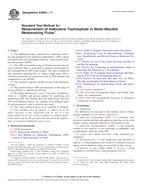
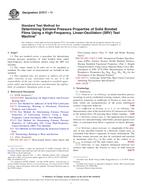 ASTM D7217-11
ASTM D7217-11 ASTM D7260-12
ASTM D7260-12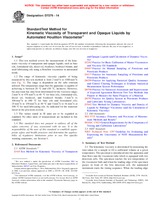 ASTM D7279-14
ASTM D7279-14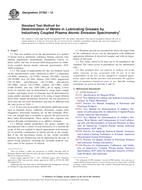 ASTM D7303-12
ASTM D7303-12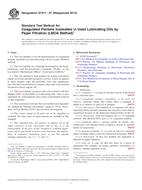 ASTM D7317-07(2013)..
ASTM D7317-07(2013)..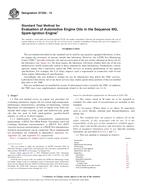 ASTM D7320-13
ASTM D7320-13
 Cookies
Cookies
